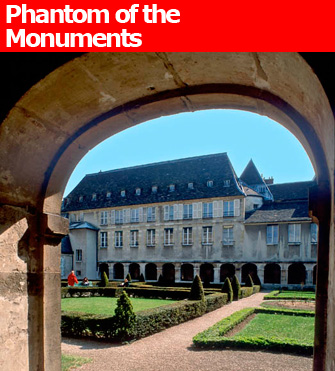 |
|
Suddenly, the serene tranquility of Port Royal Cloister was shattered by an anguished scream… Photo © Jacques Lebar, www.parimages.com |
When I was 17 years old, the little Midwestern American town I grew up in celebrated its centennial. Perhaps because I come from a place with a scant quarter-teaspoon of history, I am to this day awestruck by the remains of centuries- and millennia-old civilization here in Europe. I love the historic buildings of Paris, and I never tire of the Roman ruins that make up much of the Cluny Museum and all of the Arènes de Lutèce park.
To venture away from the capital, I nearly levitate from amazement in front of the Cro Magnon cave paintings at Pech Merle and Font de Gaume in southwestern France (where you can still see the real 20,000-year-old thing, not a facsimile).
And to venture out of the country, the ancient city of Pompeii south of Naples sends me into fits of rapture that make John Hurt’s final scene in Alien look dispassionately underplayed. It just blows my cervello that you can actually walk down a Roman street from 79 AD and look into all the buildings.
The first time I went to Pompeii, about 25 years ago, there were watchmen roaming the grounds whom you could bribe, I mean tip, to open the buildings that were fenced off, which of course were the most beautiful and interesting ones. My wife and I latched onto a very accommodating guard who was already showing another American tourist around (because he was very blatantly trying to pick her up, and she very glaringly didn’t get it, but that’s beyond the scope of this article), and we got to visit a number of restricted-access areas.
I was in heaven, wandering among the rooms of well-preserved patrician mansions and gorging my eyes on the rich decorations. I remember one house especially vividly for its fine architectural details and the elaborate multicolored frescoes surrounding the peristyle. And for the inscription marring one of them, carved a half-inch deep into the plaster in letters ten inches high: “MARCO 1983.”
Normally I’m a hemorrhaging-heart liberal, but when I saw that, I started rethinking my position on capital punishment. Then I started rethinking my position on due process. I quite simply don’t get it: how can anyone be sentient enough to want to go to Pompeii, arguably the world’s most incredible archaeological site, and yet be brain-dead enough to deface a fresco? Not a map or a billboard or even a stone pillar, but a two-thousand-year-old wall painting that the words “rare” and “priceless” barely even begin to describe?
Back in France a few years later, I discovered a wonderful book published by Parigramme called (in its English version) Undiscovered Paris, a guide to the city’s little-known historical and architectural oddities. My curiosity was aroused in particular by a place in the 14th arrondissement: one of Paris’s few remaining Renaissance cloisters. Most ecclesiastical property was destroyed during the Revolution, but the Port Royal Cloister survived essentially intact and now serves as the courtyard and garden of Baudelocque Hospital (123-25 Boulevard de Port Royal). Thing is, though, it’s only open to the public at odd hours, and I went to see it several times only to find the entrance locked. So I was very happy one Sunday morning when I was in the neighborhood, decided to try again and saw that the gate was wide open.
Savoring the moment, I tiptoed reverentially in and began soaking up the scene before me. And one of the first things I saw, at eye level on the first column I passed, was a name scratched into the stone: “Marco.” I’m not kidding.
I like to think it’s the same guy, a lobotomized latter-day Marco Polo who goes around vandalizing the world’s most spectacular, venerated sites. Marco Schmolo, scourge of historians and archaeologists. In a few years, by the time he has etched his name all over Angkor Wat, Machu Picchu, the moai statues of Easter Island and the summit of Mount Everest, with any luck tourist flights to the moon will be available and he can branch out to new territory. I’d be glad to pay for his trip. Or rather half of it.
The Port Royal Cloister is always open on Sunday mornings from 10:30 to 11:30.
Next week: The little-known wonders and horrors of Paris part two: Royal blood on canvas at the Louvre?

Order Paris Secret et Insolite or its English version, Unexplored Paris, from Paris Update’s Amazon. Click on your preferred Amazon location: U.K., France, U.S.
© 2011 Paris Update
Favorite
An album of David Jaggard’s comic compositions is now available for streaming on Spotify and Apple Music, for purchase (whole or track by track) on iTunes and Amazon, and on every other music downloading service in the known universe, under the title “Totally Unrelated.”
Note to readers: David Jaggard’s e-book Quorum of One: Satire 1998-2011 is available from Amazon as well as iTunes, iBookstore, Nook, Reader Store, Kobo, Copia and many other distributors.
